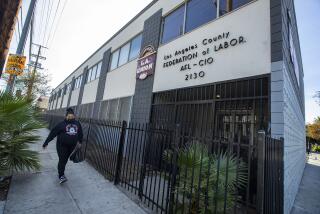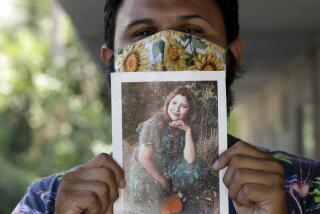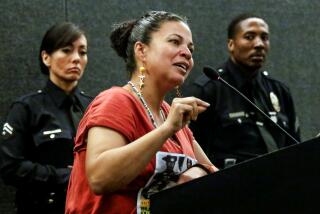This is the shooting video Gardena police didn’t want you to see

A federal court ordered the release of police videos that show Gardena officers fatally shooting one unarmed man and wounding another in 2013.
The day after the release of videos showing Gardena police officers shooting two unarmed men, one fatally, the survivor and the deceased victim’s brother called for a deeper investigation into the Gardena Police Department.
The brother of Ricardo Diaz Zeferino, who was killed in the 2013 shooting, spoke in front of the Edward R. Roybal Federal Building in Los Angeles on Wednesday as he clutched a copy of a photo of him and his brother.
“Nothing is sufficient, not even the money. A life is more important than the money,” said Augustin Reynoso, Diaz Zeferino’s brother. “I want the Gardena Police Department to be investigated more deeply. That’s why I’m here, for justice.”
Reynoso was joined by his family’s attorney, Sonia Mercado, as well as Eutiquio Mendez, who was wounded in the shooting, and Mendez’s attorney, R. Samuel Paz.
The attorneys called for the Department of Justice to investigate the Gardena Police Department.
“We have asked for an investigation into the civil rights violations by these officers, which we think merits a prosecution,” Paz said. “We hope this case will become an example ... of what a police department should not be doing.”
------------
FOR THE RECORD
2:45 p.m.: A previous version of this story incorrectly referred to Sonia Mercado as Susan Mercado.
------------
The U.S. attorney’s office said it was “reviewing the matter” but had not formally opened an investigation. “As of this time, there is no investigation,” spokesman Thom Mrozek said.
Video of the shooting that killed Diaz Zeferino was unsealed by a federal judge Tuesday after months of legal battles between the city and media outlets, including the Los Angeles Times.
The grainy videos, captured by cameras mounted in two patrol cars, show three men mistakenly suspected of stealing a bicycle standing in a street under the glare of police lights. With their weapons trained on the men, officers scream at them to keep their hands up.
While two of the men in the videos remain motionless, Diaz Zeferino appears confused by the officers’ instructions. He drops and raises his arms repeatedly, showing the officers his hands and stepping backward and then forward a few paces. A laser dot from an officers’ pistol can be seen on his shirt. After Diaz Zeferino removes a baseball cap from his head, officers standing to the side of the men unleash a volley of gunfire.
The videos show Diaz Zeferino, 35, collapsing to the ground, along with Mendez, who was wounded.
At Wednesday’s news conference, Mercado said Diaz Zeferino had gone for a beer and to play pool around midnight June 2, 2013, after working 12 hours. He was later shot eight times by police.
“Mr. Ricardo Diaz Zeferino was a human being,” Mercado said. “We’re here so the Department of Justice will investigate this Police Department. Enough.”
Diaz Zeferino worked in a restaurant 12 hours a day, seven days a week and helped support his parents and his two sisters — one who had an amputated leg and one who was studying to be a nurse, Reynoso said Wednesday.
“He was a good brother,” said Reynoso, whose bicycle was stolen the night of the shooting.
Mendez, who still has a bullet fragment lodged next to his spine, also spoke briefly. Mendez said Diaz Zeferino had been cooperating with police that night and was trying to tell them that the two other men were not the bicycle thieves.
The police didn’t listen to him, Mendez recounted.
“I feel nervous being here, but I want justice and an investigation. What they did to us isn’t just,” Mendez said. “They said they were going to investigate, but nothing’s been done and the police continue working.
“I’m still traumatized by what happened. I’m not doing well,” Mendez said. “I know I’m never going to be OK.”
Mendez said that when Diaz Zeferino was shot, he heard him fall and say, “... I won’t see you again.”
And then Mendez fell unconscious, he said.
Mercado said the family called for the U.S. Department of Justice to set up an independent unit to investigate police shootings nationwide.
“Today we ask that they begin with the Gardena Police Department,” Mercado said.
In unsealing the videos Tuesday, U.S. District Judge Stephen V. Wilson said the public had an interest in seeing the recordings, especially after the city settled a lawsuit over the shooting for $4.7 million. Wilson rejected last-ditch efforts by Gardena attorneys, who argued the city had paid the settlement money in the belief that the videos would remain under seal.
The “defendants’ argument backfires here — the fact that they spent the city’s money, presumably derived from taxes, only strengthens the public’s interest in seeing the videos,” Wilson wrote. “Moreover, while the videos are potentially upsetting and disturbing because of the events they depict, they are not overly gory or graphic in a way that would make them a vehicle for improper purposes.”
The judge’s decision was a response to a request from The Times, the Associated Press and Bloomberg, which challenged a blanket protective order that had prevented the release of the videos and other evidence in the court case.
Wilson’s decision comes as law enforcement agencies nationwide increasingly have embraced the use of cameras worn by officers and placed in patrol cars to record police interactions with civilians. But few agencies have made their videos public, spurring a debate over the need to balance the privacy of those captured on the recordings and transparency in policing.
After ordering the videos to be released, Wilson denied a request from Gardena attorneys that he set aside his order as they pursued an appeal of his decision. The city then filed an emergency motion with the 9th Circuit Court of Appeals, asking it to intervene.
The Times, meanwhile, received copies of the videos from court officials. After The Times published the videos online, 9th Circuit Judge Alex Kozinski issued an order that “the police car camera video footage shall remain under seal pending further order of this court.”
Gardena Police Chief Ed Medrano released a statement late Tuesday describing the shooting as “tragic for all involved.”
“We have thoroughly reviewed our response and have initiated new training, including the tactical use of cover techniques to slow down fast-moving events,” he said.
He said Gardena police officers will soon be equipped with body cameras and that he continues to oppose publicly releasing recordings out of privacy concerns.
“Our police officers are entrusted with sensitive and extremely personal information and we often come in contact with people under tragic situations and at their worst,” he said. “We worry about the implications of this decision and its impact on victims and average citizens who are recorded by the police.”
The Gardena shooting occurred the night of June 2, 2013, after police responded to a call about a bicycle stolen from outside a CVS drugstore. A police dispatcher mistakenly told officers the crime was a robbery, which typically involves weapons or force.
A sergeant responding to the call saw two men riding bicycles near the store. Mistaking them for the thieves, the sergeant stopped the men, according to a memo written by a prosecutor from the L.A. County district attorney’s office, who reviewed the case.
Diaz Zeferino ran up to join the other two men as police detained them. One patrol car video shows him continuing to walk toward his friends despite an officer shouting at him to stop. On the videos, officers can be heard repeatedly telling Diaz Zeferino to keep his hands up as he moves his arms up and down.
The three officers who opened fire — Christopher Mendez, Christopher Sanderson and Matthew Toda — were standing to the left side of the men.
The district attorney’s office declined to file charges against the officers. Deputy Dist. Atty. Rosa Alarcon wrote in a memo about the shooting that Diaz Zeferino ignored police commands and that toxicology tests after his death were postive for alcohol and methamphetamine. His right hand, she wrote, was no longer visible from the officers’ angle when they opened fire and it was reasonable for them to believe he was reaching for a weapon.
“They made a split-second decision and they were not required to hold fire in order to ascertain whether Diaz would, in fact, injure or kill them,” she wrote.
When Diaz Zeferino’s relatives and the other men filed a federal lawsuit against Gardena, attorneys for the men complained to Wilson that the city was dragging its feet in providing them with information about the shooting, according to Wilson’s written ruling. Before turning anything over, attorneys for Gardena insisted on a protective order that would prevent the release of evidence in the case, Wilson wrote.
The city argued that the videos showed that Diaz Zeferino repeatedly ignored police commands and reached into his pockets and waistband area. But attorneys suing the city contended that the recordings showed a cold-blooded shooting of clearly unarmed men.
In May, when The Times first reported that the city had settled a civil rights lawsuit over the shooting, Medrano said the officers who opened fire were still on patrol. He said at the time that the department’s internal investigation to determine whether discipline is warranted had been put on hold during the civil litigation.
Under California law, the outcome of the disciplinary investigation will remain confidential.
After settling the lawsuit, Diaz Zeferino’s family and the other men supported the request of The Times and other media groups, saying the videos should be released. Gardena contended that releasing the video would deter police from using such cameras and would endanger the safety of its officers at a time of heightened public criticism of police killings.
The fact that the media groups needed an order from a federal judge to get access to the videos underscores the limited scope of California’s laws on public records, said Peter Scheer, executive director of the First Amendment Coalition. The city had previously rejected The Times’ request for the video.
Under the state’s open records laws, Scheer said, Gardena police officials were well within their rights to keep the video footage secret.
“The take-away from this should be that California laws protecting police information and evidence are way too restrictive and make it too difficult to know what is going on,” Scheer said.
For more news on Southern California crime, follow @lacrimes on Twitter.
Hoy: Léa esta historia en español
ALSO:
Police killings in L.A. County since 2000
Gardena police shooting video: City Council silent but gets an earful
Gardena police officer describes moments leading up to deadly shooting of unarmed men
More to Read
Sign up for Essential California
The most important California stories and recommendations in your inbox every morning.
You may occasionally receive promotional content from the Los Angeles Times.













